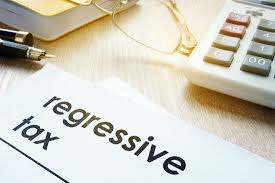A regressive tax is a tax system in which the tax rate drops as the taxpayer’s income increases. This post is to expose you to what a regressive tax is, which basically is a definition and a couple of examples to get a hang of this in no time.
Regressive Tax
By definition, a regressive tax unfairly targets low-income individuals more than high-income individuals since it is applied consistently to all circumstances, regardless of the taxpayer. While taxing everyone at the same rate may be reasonable in some contexts, it is viewed as unjust in others. As a result, the majority of income tax systems use a progressive schedule that taxes high-income earners more heavily than low-income earners, whereas other types of taxes are administered uniformly.
Although the United States has a progressive income tax system, which means that individuals with a higher income pay a higher percentage of taxes each year than those with a lower income, we do pay some levies that are deemed regressive.
Different Types of Regressive Taxes
Regressive taxation can occur in a variety of various levies that have a uniform tax rate. Nonetheless, the extent to which regression occurs varies.
#1. Sales Tax
Sales taxes are levied on the majority of consumer items. They are generally regressive since they are equally in payment and affect all economic groupings within a population.
#2. Sin Tax
Sin taxes are imposed on items seen to be damaging to society. Tobacco, alcohol, and products containing an excessive amount of sugar are included in the goods. Due to the demand disparities between low- and high-income segments of the population, sin taxes are highly regressive. Numerous studies demonstrate that persons with lower incomes use more dangerous products such as tobacco or alcohol than those with higher incomes.
#3. Property Tax
In theory, property taxes are regressive. In determination by the property’s market value. Real estate is tangible personal property that comprises land and improvements such as structures, buildings, fixtures, roads, and utility systems. and not based on the owner’s earnings. Thus, if a person with a low income and a person with a high income possess identical properties, they will pay the same amount of tax.
What Is A Regressive Tax
By definition, a regressive tax is consistently imposed and takes a greater proportion of revenue from low-income earners than from high-income ones. It is opposed to a progressive tax, which taxes high-income taxpayers more heavily.
This type of tax burdens low-income earners more than it does high-income earners, for whom the same dollar amount amounts to a significantly higher percentage of total income earned.
In the United States and certain other industrialized nations, income is taxed progressively, while other taxes, such as sales tax and user fees, are uniform.
Note: A regressive tax system is more prevalent in less developed countries, since there are more people in the same income band, lowering the regressive tax’s adverse influence. To understand fully the definition of a tax regressive, we need to also understand its advantages and disadvantages.
Advantages of Regressive Taxation
Here are the benefits of regressive taxation:
#1. Inspires individuals to earn more
According to the definition, individuals with higher incomes pay less tax under a regressive tax policy. This provides an incentive for individuals with lower salaries to climb the income ladder. In comparison, a progressive tax charges individuals more when they approach higher tax categories. Thus, for someone earning $39,000, earning $50,000 and moving into a bracket that pays an additional 10% makes little sense.
A regressive tax removes this disincentive and instead increases it. It motivates individuals to advance into more productive and well-compensated careers. At the same time, it can catalyze entrepreneurs who are tired of working in a mundane 9 to 5 job they despise.
#2. Increased Revenues
This may sound counterintuitive, but when taxes on the wealthy are lower, they are less likely to resort to extreme means to avoid paying them. Instead of money moving to countries like Switzerland and Monaco, it is taxed and handed to the government. This is because the incentive to avoid it is reduced. For instance, tax evasion costs the wealthy millions in legal and accounting bills. As the tax rate is cut, the cost-benefit ratio of hiring those professionals decreases as well.
#3. Contributes to increased savings and investment
Under a regressive tax structure, those with higher earnings save more, boosting the nation’s saving rate. These savings are then converted to capital, which businesses can use to invest in new, more productive, and efficient equipment.
#4. Simplicity
Numerous regressive taxes are likewise flat taxes, but they are regressive in that they disproportionately burden lower-income households. They are, nevertheless, extremely simple to implement. For example, the sales tax is clear – 5% on every item. In comparison, the progressive income tax must be computed to establish the bracket, the amount earned on the additional income, and the amount charged as capital gains. While administering such a system would need thousands of personnel, a flat regressive tax is straightforward.
#5. Minimizes ‘Brain Drain’
When tax rates become more progressive, they might result in a loss of talent, colloquially referred to as ‘brain drain.’ This is the process by which competent professionals leave the country in search of work. By instituting a progressive tax system that penalizes the wealthy, highly trained people are enticed to relocate.
For instance, someone who has worked for ten years to earn $150,000 a year as a surgeon may have a 50% marginal tax rate. All that effort and sacrifice, only to have half their income taken away. As a result, people may seek out other countries that have a more regressive but objectively fairer tax system.
The Disadvantages of Regressive Taxation
Here is the list of the back draws of regressive taxation:
#1. Inequality
In the definition, a regressive tax burdens those with lower earnings more than those with higher incomes. As a result, it exerts downward pressure on the amount of money that low-income households may save. They are compelled to pay a higher proportion of their incomes in taxes, leaving less room for savings. With less money, it becomes more difficult to enter the housing market and build equity through property ownership. As a result, a poverty trap is in creation in which low-income people are burdened by taxes, preventing them from amassing wealth.
#2. Increased Prices
Naturally, the higher the tax, the higher the price. However, is frequently questioned for a regressive tax such as tariffs. Tariffs are not always passed on to the purchaser, as imported goods may absorb some of the cost. It is, however, primarily borne by the consumer, as businesses seek to safeguard their profit margins.
Additionally, the consumer faces higher prices for other things. For example, excise taxes can be In established on sugary beverages, cigarettes, and alcohol all of which are frequently connected with low-income households.
#3. Limits Choice
Excise taxes, tariffs, and sales taxes are all examples of regressive taxes that contribute to decreased demand for commodities. This decreased demand makes it more difficult for a broader range of businesses to make a profit. As prices rise, demand decreases, and as demand decreases, there is less room for competition.
Simultaneously, lower demand levels make it more difficult for existing enterprises to fully exploit the same economies of scale.
#4. Political Unrest
Taxation will always be a matter of morality by the definition of a regressive tax. However, when it begins to disproportionately affect a large number of homes, people can grow dissatisfied. When people see wealthy and international corporations paying little tax, as they do today, it becomes a big moral issue. We prefer a just system, therefore it’s reasonable that the public feels outraged when the wealthy pay so little tax. As a result, we frequently see abrupt turns in the political sphere – either to the left or to the right.
Example of Regressive Tax
A regressive tax is one in which you can reduce the tax rate. In comparison, a progressive tax increases in lockstep with income. Thus, the higher an individual’s income, the greater the percentage of compensation paid in taxes.
While this may appear to be a regressive tax, it is not. Rather than that, the tax code has become so intricate and diverse that millionaires can exploit the system such as through loss rollover. This enables businesses and individuals to carry forward profits from year to year, so decreasing the amount of tax to be payable.
There are other additional devious ways for the wealthy to cut their effective tax rate, but the real tax rates are progressive. For example, in the United States, the marginal tax rate ranges from 10% for individuals earning less than $10,000 to 37% for those making more than $510,000. While many may notice a reduction in the percentage of taxes paid by the wealthy, the actual tax rates are not regressive. Rather than that, the tax system’s structure enables such individuals to control the amount they pay.
However, example of a regressive tax, includes sales taxes, property taxes, excise taxes, tariffs, and government fees, to name a few.
#1. Sales Tax
Generally, the sales tax is an example of a regressive tax, which is imposed at a uniform rate throughout the board. Whether the rate is 5%, 10%, or 20%, it applies to all goods in the economy. Therefore, the sales tax on a Nike shirt will be the same for someone earning $20,000 per year at Walmart as it will be for an Apple executive earning $1 million per year.
This is an example of a regressive tax, as the Walmart employee earning $20,000 per year will spend a greater portion and maybe even the entirety of it. This means that 100% of their income will be liable to sales tax, which would represent 20% of their pay at a 20% sales tax rate. However, a CEO earning $1 million per year may spend only 15% of their earnings. Thus, a 20% tax on that would equate to 3% of their income being spent on sales tax.
#2. Property Tax
Property taxes are often based on the market value of the home, implying that they are largely neutral; and is also an example of a regressive tax The higher the purchase price of a home, the greater the tax liability. This is in association with greater income levels. Individuals with a greater income will typically live in a more valuable home. While this is generally accurate, there is a regressive element to it.
Consider two adjacent households. Both residences are equal in value, with one being occupied by a young family earning $50,000 per year. They have a substantial mortgage on the property and will be bound to repay it for another 30 years. In comparison, the other home is headed by a mature couple who earn $600,000 a year as executives at a bank. While both residences are equal in value, their respective incomes are quite different.
Both households will pay the same amount of tax yet earn very different amounts implying that the tax is levied in some situations.
#3. Tax on Excise
Excise taxes are another example of a regressive tax; which is levied throughout the production process before the product reaches the consumer. It is payable by the maker regardless of whether they sell the goods or not. The primary objective is to reduce the consumption of products that are harmful to the individual and/or generate negative externalities. For instance, while smoking and drinking are both harmful to the individual, they can also be harmful to others through second-hand smoke or drunk driving.
Excise taxes are another type of flat tax, although they disproportionately affect the poor. If it is based on commodities that are mostly purchased by the poor, it will be regressive. For example, because low-income households tend to purchase more sugary beverages, an excise tax on such beverages will disproportionately affect the poor.
#4. Tariff
When you increase the tariffs, products entering the country become more expensive. It is essentially an indirect tax on the poor, which disproportionately affects them. This is because low-income individuals must spend a greater proportion of their income on commodities. As a result, each increase in the price of such commodities consumes a greater proportion of their income.
For example, a $100 increase in the price of monthly groceries is a 10% increase for someone who spends $1,000 each month. However, for someone making $10,000 per month, this would represent a 1% gain. As a result, people with higher incomes pay less in terms of percentage of salary than those with lower incomes, making tariffs a regressive tax.
#5. Taxes and Fees
Whether it’s for a driver’s license application, park admission fees, or other government services, the pricing is the same. For instance, a $30 price for a new license represents a greater percentage of income for someone making $1,500 per month than it does for someone earning $10,000 per month.
Additionally, there are road charges, which are normally greater for motor vehicles that emit more carbon dioxide. Automobiles manufactured before the year 2000 are often less fuel-efficient and so liable to higher tax rates. This makes it a regressive tax, not just because low-income households can typically only afford older cars, but also because electric and more fuel-efficient vehicles are more costly.
#6. Flat Taxes
The term “flat tax,” another example of a regressive tax; which is frequently useful in income tax disputes, refers to a taxation system in which the government taxes all income at the same rate regardless of wages. There are no particular deductions or credits available under a flat tax. Rather than that, each individual pays a fixed percentage of total income, making this a regressive tax. As a result, lower-income individuals effectively pay the same rate as higher-income individuals rather than lower-income individuals.
Is a Flat Tax Regressive?
Yes, it is a regressive tax. The term “flat tax,” which is frequently used in income tax disputes, refers to a taxation system in which the government taxes all income at the same rate regardless of wages. There are no particular deductions or credits available under a flat tax.
What Is Meant by Regressive Taxation?
A regressive tax unfairly targets low-income individuals more than high-income individuals since it is applied consistently to all circumstances, regardless of the taxpayer.
What Are 2 Examples of Regressive Taxes?
Examples of regressive taxes include sales taxes, property taxes, excise taxes, tariffs, and government fees, to name a few.
- Sales Tax
- Property Tax
- Tax on Excise
Why Is Regressive Tax the Best?
Regressive taxes lower the demand for products such as tobacco and alcohol. As a tax, it pushes people to earn more. The tax rate will be set and unaffected by earned income.
Who Is Affected Most by a Regressive Tax?
A regressive tax is one that impacts persons with lower incomes more than those with higher incomes. These taxes comprise a larger proportion of a low-income individual’s income. Transaction taxes and other non-income-based taxes are typically regressive.
Who Pays More Taxes Rich or Poor?
A progressive tax is one in which the average tax burden rises with increasing income. Low- and middle-income taxpayers carry a relatively minor tax burden, whereas high-income families shoulder a disproportionate amount of the tax burden. An excise tax is a levy on a particular good or activity.
What States Have No Income Tax?
Eight states, including Alaska, Florida, Nevada, South Dakota, Tennessee, Texas, Washington, and Wyoming, do not impose a tax on residents’ personal income.
Related Article
- SMALL BUSINESS INSURANCE: Overview, Liability, Requirements, Costs
- COMMUNITY SERVICE BLOCK GRANT: Programs, Applications, Scams
- 8 Reasons Why You Should Study Digital Marketing
- FORM 720 (Excise Taxes): Instructions and Guidelines
- 1031 EXCHANGE FLORIDA: Tax Exchange Rules, Timeline, and Processes (Updated!)






